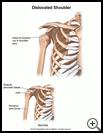
Shoulder Dislocation: Teen Version
What is a shoulder dislocation?
A shoulder dislocation means that the bones in your shoulder joint have moved out of place so that the joint no longer works properly.
Your shoulder is made up of two bones: the ball (the end of the arm bone) and the socket (part of your shoulder blade). When the joint is dislocated in front of the socket, it is called anterior. When it is dislocated behind the socket, it is called posterior. In severe cases, ligaments, tendons, and nerves are also stretched and injured.
How does it occur?
An anterior dislocation can be caused by a fall onto your hand or your shoulder. It may also happen if your arm is forced into an awkward position. This is the most common type of dislocation.
A posterior dislocation may be caused by a blow to your shoulder, or by twisting your upper arm.
Dislocated shoulders are common in sports such as football, rugby, hockey, and lacrosse. Other sports that may cause the injury include downhill skiing, volleyball, and soccer.
If your shoulder goes out often or easily, it may be a problem that you were born with. Other members of your family may have the same problem.
What are the symptoms?
The main symptom is pain in your shoulder and upper arm when you move.
If you have an anterior dislocation, you tend to hold your arm on the dislocated side slightly away from your body. This will keep the shoulder in the least uncomfortable position. Your shoulder will have a large bump under the skin in front of your shoulder. Your shoulder will look square instead of round.
If you have a posterior dislocation, you tend to hold your arm on the dislocated side tightly against your body. You will have a large bump on the back of your shoulder.
How is it diagnosed?
Your healthcare provider will ask about your medical history, including your symptoms, previous treatment, and family history. During your physical exam, he or she will check for:
- shoulder tenderness and weakness
- numbness in the shoulder area, arm, or hand
- pain when you move your shoulder or loss of normal shoulder movement
- shoulder instability and deformity
You will have an X-ray of the shoulder to check for broken bones and confirm the dislocation.
What is the treatment?
You should go to your healthcare provider's office or the hospital emergency room right away if your shoulder is dislocated. Put ice on your shoulder. Cold helps reduce the pain, swelling, and inflammation.
Your provider will reposition the head or ball of the joint back into the joint socket. This may be done without an anesthetic if it is done within a few minutes after the dislocation occurs. If you have recurrent dislocations, you may be able to learn how to put your shoulder back into place by yourself. However, even in such cases you should see a healthcare provider promptly to make sure the repositioning has been done properly.
Fifteen to thirty minutes after the injury, your dislocated shoulder will probably be quite swollen and painful. You may need pain medicine and muscle relaxant or general anesthesia before the healthcare provider repositions your shoulder. Sometimes a local anesthetic can be injected into the joint. After the repositioning, your shoulder will be X-rayed to make sure it is in the correct position.
Your healthcare provider will place your shoulder and arm in a type of sling called a shoulder immobilizer. It keeps your arm next to your body and stops you from moving your shoulder. You will keep your shoulder and arm in the immobilizer for 2 to 3 weeks. You may start rehabilitation exercises during this time or after you are no longer wearing the immobilizer.
Take an anti-inflammatory such as ibuprofen, or other medicine as directed by your provider. Nonsteroidal anti-inflammatory medicines (NSAIDs) may cause stomach bleeding and other problems. These risks increase with age. Read the label and take as directed. Unless recommended by your healthcare provider, do not take for more than 10 days.
Put an ice pack, gel pack, or package of frozen vegetables, wrapped in a cloth on the area every 3 to 4 hours, for up to 20 minutes at a time.
In some cases, surgery may be needed. If your shoulder joint becomes weak because of repeated dislocations, your healthcare provider may recommend an operation to tighten the ligaments that hold the joint together.
How long will the effects last?
The healing process may take 4 to 12 weeks, depending on your injury. With proper healing, you should regain full movement of your shoulder.
How can I take care of myself?
Follow your healthcare provider's instructions when you begin to use your arm and shoulder again, or you may reinjure it. Do the rehabilitation exercises that are given to you by your provider or therapist. Avoid participation in sports until the shoulder has had time to heal.
When can I return to my normal activities?
Everyone recovers from an injury at a different rate. Return to your activities depends on how soon your shoulder recovers, not by how many days or weeks it has been since your injury has occurred. The goal is to return to your normal activities as soon as is safely possible. If you return too soon you may worsen your injury.
You may safely return to your activities when:
- Your injured shoulder has full range of motion without pain.
- Your injured shoulder is as strong as the uninjured shoulder.
If you feel your arm popping out of the shoulder joint, contact your healthcare provider.
What can be done to help prevent a dislocated shoulder?
- Avoid situations in which you could suffer another dislocation.
- Wear layers of clothing or padding to help cushion falls.
- Do not return to sports until you have full range of motion and strength in your arm.
Last modified: 2011-02-08
Last reviewed: 2010-06-21

